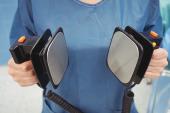Level of Consciousness After Cardiac Arrest Correlates With Post-PCI Outcomes
Mental status should help inform the timing of PCI, given that less responsive patients fare worse, researchers say.

For cardiac arrest patients who subsequently undergo PCI, their degree of consciousness before the procedure is a strong predictor of in-hospital outcomes, according to observational data from Michigan.
As such, researchers argue that this information should be documented and more consistently considered when thinking about the timing of coronary revascularization.
“This space of postarrest care is one that is difficult, and there is no perfect answer to what factors should be used for prognostication in a perfect way,” lead author David E. Hamilton, MD (University of Michigan, Ann Arbor), told TCTMD, adding that the challenges of that timeline merit more research to clarify the best strategy. “What our study adds is another large set of data with thousands of patients that reiterates that mental status after an arrest situation is very important, especially in these patients that then undergo PCI.”
Clinicians who treat cardiac arrest patients currently vary in their approach as to how the extent of consciousness affects their care strategy, he added. “Our recommendation from this study is that among all of the other prognostic factors that go into decisions like this, such as the CT scan and their postarrest metabolic insult, taking into account their mental status is important and something to add to that list of factors” informing decisions on PCI timing.
Previous research has linked an earlier invasive strategy to better survival in patients with out-of-hospital cardiac arrest, but some argue there are benefits of letting patients recover from their neurological injuries before proceeding with PCI. In 2019, the American Heart Association published a document in favor of incorporating better neurological assessment before making care decisions.
The new results were published online ahead of print earlier this month in Circulation: Cardiovascular Interventions.
In an accompanying editorial, Anna E. Bortnick, MD, PhD (Montefiore Medical Center and Albert Einstein College of Medicine, Bronx, NY), writes that “the level of consciousness on presentation may be helpful to add to the balance of the various factors that go into the decision to pursue immediate or delayed revascularization for patients with cardiac arrest and STEMI, knowing that unresponsive patients fare worse.”
Because of this, she says “state and institutional PCI registries should consider adding a level of consciousness, as the NCDR CathPCI does, for improved risk adjustment and findings on pre-PCI head CT imaging as a variable to better understand its utility for unconscious postarrest patients referred for catheterization.”
From Unresponsive to Alert
For the study, Hamilton and colleagues included 3,021 patients (mean age 63.1 years; 26.5% female) who, after experiencing either in-hospital or out-of-hospital cardiac arrest, underwent PCI at one of 48 hospitals in Michigan between April 2018 and March 2022. All data was taken from the Blue Cross Blue Shield of Michigan Cardiovascular Consortium (BMC2) registry. In total, 94.5% of patients had their level of consciousness (LOC) classified before their PCI as follows:
- Mentally alert (48.8%)
- Partially responsive (4.6%)
- Unresponsive (24.4%)
- Unable to assess (22.1%)
Median time from admission to PCI was 76 minutes, ranging from 65 minutes in partially responsive patients to 81 minutes in patients unable to be assessed. LOC was most commonly assessed before the patient reached the healthcare facility (48.2%) and at the facility where PCI was performed (41.8%). PCI was most often indicated for STEMI (61.6%) and NSTEMI (22.9%).
In-hospital mortality following PCI was more likely for those who were partially responsive (17.4%; adjusted OR 4.63; 95% CI 2.67-8.04), unable to assess (38.0%; adjusted OR 13.95; 95% CI 9.97-19.51), and unresponsive (50.1%; adjusted OR 24.36; 95% CI 17.34-34.23) compared with patients who were mentally alert (4.59%; P < 0.001 for all).
Post-PCI acute kidney injury (AKI)—defined as an increase from pre-PCI creatinine to post-PCI creatinine of at least 0.5 mg/dL—was also more common in those who were partially responsive (adjusted OR 2.09; 95% CI 1.12-3.92), unable to assess (adjusted OR 7.52; 95% CI 5.49-10.30), and unresponsive (adjusted OR 7.15; 5.15-9.92). These findings held up in a sensitivity analysis using a different AKI definition: at least 0.3 mg/dL absolute increase or a 50% relative increase in serum creatinine from baseline.
Bleeding, too, was more likely in patients who were partially responsive (adjusted OR 2.16; 95% CI 1.16-4.02), unable to assess (adjusted OR 4.00; 95% CI 2.90-5.52), and unresponsive (adjusted OR 4.40; 95% CI 3.19-6.09) than in the mentally alert cohort, although these associations were attenuated after further adjustment for mechanical circulatory support and femoral access.
Another sensitivity analysis looking only at patients with STEMI found similar results with regard to post-PCI mortality. The risks of AKI and bleeding for mentally alert and partially responsive patients matched those of the mentally alert, but were higher for those who were unable to be assessed or unresponsive.
“The value of this pre-PCI level of consciousness is that it is a very quick assessment,” Hamilton said, acknowledging that it might not be possible for up to one-fifth of patients. “We're not advocating with this that you should pause sedation for somebody that's intubated and wake them up and spend 2 hours trying to figure out their mental status.” Rather, he said, “take the data that you have and in that 5 seconds that it takes to identify [LOC], add that into your prognostication.”
Hamilton said he’d like to see future studies look more closely at how LOC can change clinical outcomes in a prospective fashion. “Our limitation is that the study doesn't have all of the important factors that go into postarrest prognostication, including CT scan and arrest characteristics like bystander CPR,” he said. “Those are known to be really important.”
Additional Decision Aids Needed
Commenting on the study for TCTMD, Romergryko G. Geocadin, MD (Johns Hopkins University School of Medicine, Baltimore, MD), a neurointensivist who co-chaired the American Heart Association/Neurocritical Care Society’s scientific statement on critical care management of patients after cardiac arrest, said the study findings are important but subject to a notable caveat.
“I am concerned that the cohort used was [those with] cardiac arrest who had a PCI,” he said, specifying that these patients were already selected to have a better outcome compared with those who aren’t eligible. “This is a built-in bias.”
Geocadin said he’d like to see an all-comers trial of cardiac arrest patients to determine who would benefit from early PCI. “That is the problem that we have,” he said, noting that neurological biomarkers aren’t always available in the first few hours after the arrest when it remains unknown if the patient’s brain is salvageable.
“There are many trials going on right now that are trying to figure that out. But I think until we have those, just the outright determination of level of consciousness as a stratifier will disenfranchise a lot of patients that may still have a good outcome,” Geocadin continued. “There are certain other layers of characterization of the brain injury [we need] before we just conclude that: they're talking, therefore we should do a PCI.”
Yael L. Maxwell is Senior Medical Journalist for TCTMD and Section Editor of TCTMD's Fellows Forum. She served as the inaugural…
Read Full BioSources
Hamilton DE, Kobe DS, Seth M, et al. Association between neurological status and outcomes in cardiac arrest patients undergoing PCI in contemporary practice: insights from BMC2. Circ Cardiovasc Interv. 2024;17:e014189.
Bortnick AE. Unconscious after arrest and primary PCI in STEMI: hold or go? Circ Cardiovasc Interv. 2024;17:e014689.
Disclosures
- Hamilton reports no relevant conflicts of interest.
- Bortnick reports serving as a site principal investigator for sponsored clinical trials by CSL-Behring Inc and Amgen in the past year for which her institution compensation, receiving honoraria from Zoll and Getinge, and receiving meeting travel support from Getinge.
- Geocadin reports serving as the co-principal investigator for the ICECAP study.





Comments